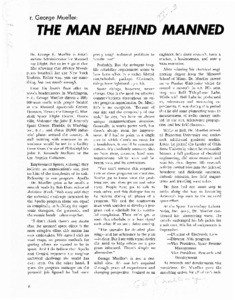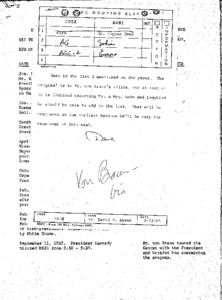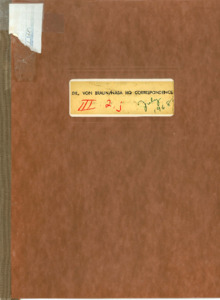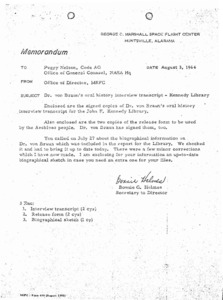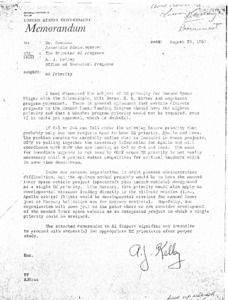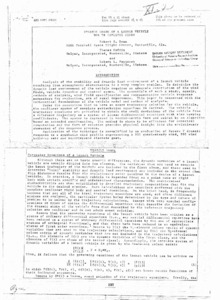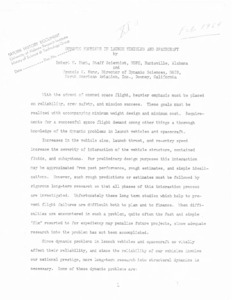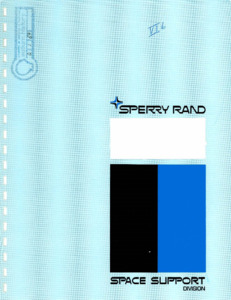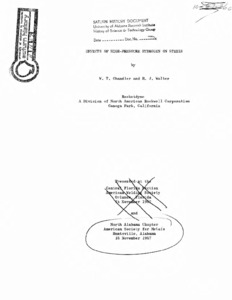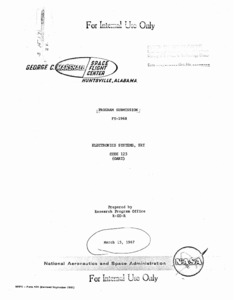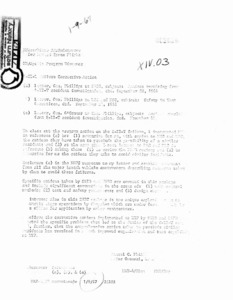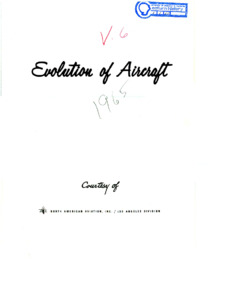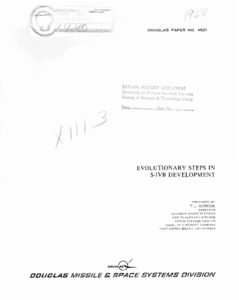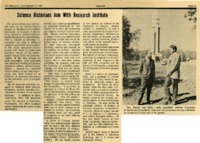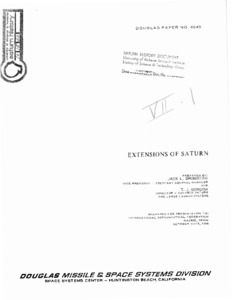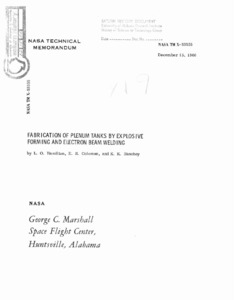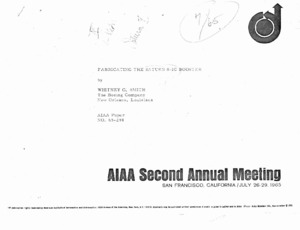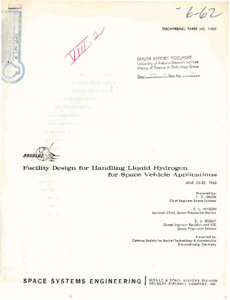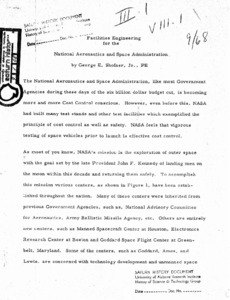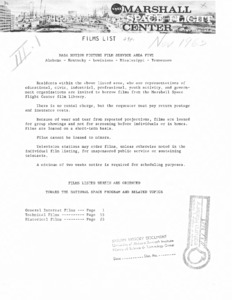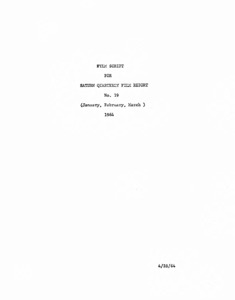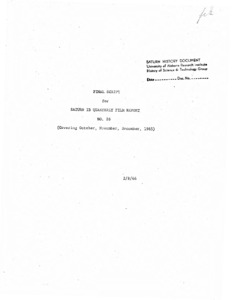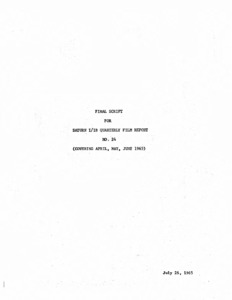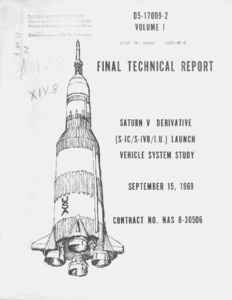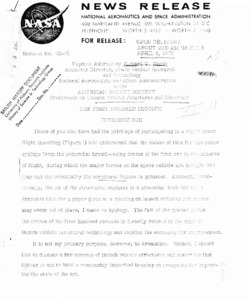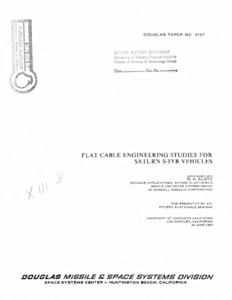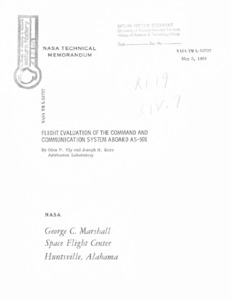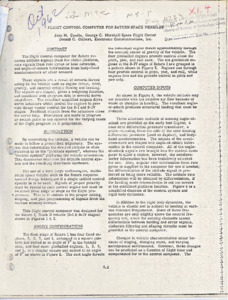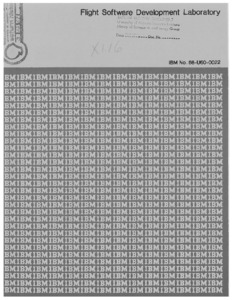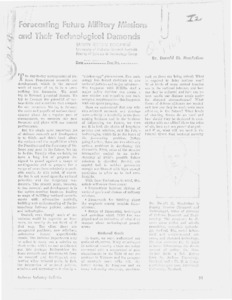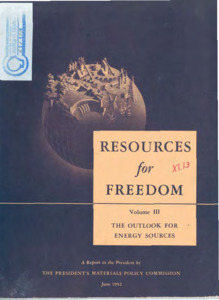
Browse Items (2178 total)
Sort by:
-
"Dr. George Mueller: The Man Behind Manned."
G. E. Challenge. Article written about George Mueller, NASA Associate Administrator for Manned Space Flight. -
Dr. von Braun's calendars and scrapbooks indicate that these were his personal contacts with President Kennedy, Vice-President Johnson and members of their immediate staff.
The first page contains a typed routing slip. A list of Wernher von Braun's meetings with President Kennedy, the Vice President and members of their immediate staff. -
"Dr. von Braun/NASA HQ correspondence: July 1968."
This contains a two page list of the correspondence which is scanned separately. It includes the date and a brief description of the correspondence. -
Dr. von Braun's oral history interview transcript - Kennedy Library: memorandum.
This memorandum references the signed copies of Dr. von Braun's oral history interview for the John F. Kennedy Library. -
DX priority: memorandum.
Memorandum discussing the priorization of various nlunar landing vehicle projects. -
"Dynamic Environments of the S-IV and S-IVB Saturn Vehicles."
The vibration and acoustic environments of the S-IV and S-IVB Stages of the Saturn vehicle are summarized. A brief review of techniques used to predict the dynamic environments of the S-IV and S-IVB vehicles is presented. This review includes discussions on the prediction of rocket exhaust noise, boundary layer noise, sinusoidal vibrations, and random vibrations for the S-IV and S-IVB vehicles. In addition, sine-random vibration conversions are given. -
"Dynamic Loads of a Launch Vehicle Due to Inflight Winds."
Analysis of the stability and dynamic load environment of a launch vehicle resulting from atmospheric disturbances is a very complex problem. To determine the dynamic load environment of the vehicle requires an adequate description of the wind field, vehicle dynamics and control system. The essential of such a study, namely methods of analysis, wind field specification and representative vehicle response parameters for evaluation, are of equal importance. This paper is concerned with the mathematical foundations of the vehicle model and method of analysis. -
"Dynamic Problems in Launch Vehicles and Spacecraft."
Addresses improving spacecraft safety by resolving various known dynamic problems. -
"Earth Orbital Workshop Capabilities Brochure."
A brochure designed to depict a competence and capability in the area of large earth-orbital workshops. -
"Effects of High-Pressure Hydrogen on Steels."
Hydrogen embrittlement of steels is hardly a new subject, but the effects of high-pressure hydrogen have been treated in detail only more recently and to a much more limited extent. Thus, most investigations of hydrogen embrittlement have been concerned with hydrogen in metals, while for the high-pressure hydrogen problem, we are more concerned with metals in(in contact with) hydrogen. I believe there is a difference and, certainly,different mechanisms of embrittlement are at least possible.; Presented at the Central Florid Section, American Welding Society, Orlando, Florida, 14 November 1967 and North Alabama Chapter, American Society for Metals, Huntsville, Alabama, 16 November 1967. -
"Engineering Capabilities Presentation."
This Engineering Capabilities Presentation lists the competence and capability that has been demonstrated by the Space Support Division of Sperry Rand Corporation while fulfilling contractual commitments in the aerospace industry. This is a preliminary presentation; the preparation of a complete capabilities history of the division is currently in the developmental stage. The Capabilities Experience Summary is comprised of ten categories. e.g. Category 1 - Aeronautics, etc. The capabilities reported herein were performed by the Space Support Division under Contract NAS8-20055 to the National Aeronautics and Space Administration, George C. Marshall Flight Center, Astrionics Laboratory, Huntsville, Alabama. -
"Engineering Safety Into Missile-Space Systems."
Safety Engineering, as applied to complex missile and space systems, has developed a new methodology referred to as "System Safety Engineering." The requirement for a comprehensive approach to safety which is included as a contractually covered adjunct to the design, development, and operational phases of a systems life cycle has become apparent from costly missile mishap experience. The general concepts and accomplishments of this new engineering discipline are described along with possible beneficial relationships with Reliability and other recognized organizational elements engaged in safety related activities. -
"Evolution of Aircraft."
Illustration depicting the history of airplanes across a graph. -
"Evolutionary Steps in S-IVB Development."
The injection stage of a multistage launch vehicle must be partially a velocity stage and partially a spacecraft; it must not only boost the payload, it must also perform cooperative mission operations with the payload after orbital insertion. These hybrid requirements result in intrinsic stage versatility which permits consideration of new and challenging missions for the stage which were unanticipated during initial design.; Prepared by T. J. Gordon, Director, Advance Space Stations and Planetary Systems, Space Systems Center, Douglas Aircraft Company, Huntington Beach, California. -
"Science Historians Join With Research Institute."
Clipping from the UAH Exponent, Wednesday, December 10, 1969, vol. 2, no. 10, page 3. The article highlights the work of Barton C. Hacker and John S. Beltz to collect historical documents from the Saturn program. The documentation they collected is available at UAH Archives and Special Collections in the Saturn V Collection. -
"Extensions of Saturn."
This paper discusses the possible applications of Saturn vehicles to future space exploration. Potential missions utilizing Apollo derived hardware are examined. Research, development, and operations in earth orbit as well as lunar exploration, unmanned and manned interplanetary exploration are reviewed. These hypothetical missions are discussed in the context of the present and potential capability of three configurations of the Saturn vehicle; an uprated Saturn I, a three-stage Saturn V and a four-stage Saturn V. NOTE: Work presented herein was conducted by the Douglas Missiles and Space Systems Division under company-sponsored research and development funds. Therefore, the concepts and objectives described within this paper reflect the opinions of the authors and do not necessarily constitute endorsement by NASA, the Air Force, or any other U.S. Government organization. The nominal performance numbers presented are typical of the current configurations and possible future vehicle configurations. -
"Fabrication of Plenum Tanks by Explosive Forming and Electron Beam Welding."
This report presents the results of a program initiated to study the use of explosive forming and electron beam fusion welding techniques in the fabrication of pressurized cryogenic materials containers. Using these techniques, vessels were successfully formed from 304 stainless steel and X7106 aluminum alloy in the T63 condition.; Manufacturing Research and Technology Division.; Manufacturing Engineering Laboratory.; Research and Development Operations. -
"Fabricating the Saturn S-IC Booster."
AIAA Second Annual Meeting, San Francisco, California. Discusses the fabrication process of the Saturn S-IC booster. -
"Facility Design for Handling Liquid Hydrogen for Space Vehicle Applications."
Presented to German Society for Rocket Technology & Astronautics.Essay discussing the capabilities of liquid hydrogen as fuel. -
"Facilities Engineering for the National Aeronautics and Space Administration."
Article makes references to a film. Centers around the idea that testing space vehicles extensively before launch is cost control. -
"Fact Sheet : IBM Computer Will Direct Saturn Orbital Test Flight."
Press release regarding a IBM digital computer directing a Saturn 1B orbital mission. -
"Failure Investigations of Large Liquid Propelled Rocket Engine Components."
Case histories of seven typical failures in large liquid propelled rocket engines components have been prepared. Quite simple to complex investigations are presented covering a variety of failure modes in a variety of materials. Included are successful solutions to the failure problems investigated.; Archive copy is a poor photocopy. -
"Films List : NASA Motion Picture Film Service Area Five: Alabama - Kentucky - Louisiana - Mississippi - Tennessee."
A list of films oriented towards the National Space Program and other related topics. -
"Film Script for Saturn Quarterly Film Report, Nr. 20 (April, May, June) 1964."
Film script for the Saturn Quarterly Film Report - April through June, 1964. -
"Film Script for Saturn I/IB Quarterly Film Report, Nr. 22 (Covering October, November, December 1964)."
Film script for the Saturn Quarterly Film Report - October through December, 1964. -
"Film Script for Saturn I/IB Quarterly Film Report, Nr. 23 (Covering January, February, March 1965)."
Film script for the Saturn Quarterly Film Report - January through March, 1965. -
"Film Script for Saturn Quarterly Film Report, No. 19 (January, February, March) 1964."
Film script for the Saturn Quarterly Film Report - January through March, 1964. -
"Final Script for Saturn IB Quarterly Film Report, No. 26 (covering October, November, December, 1965)."
Film script for the Saturn Quarterly Film Report - October through December, 1965. -
"Final Script for Saturn I/IB Quarterly Film Report, No. 24 (covering April, May, June 1965)."
Film script for the Saturn Quarterly Film Report - April through June, 1965. -
"Final Technical Report: Saturn V Derivative (S-IC/S-IVB/I.U.) Launch Vehicle System Study: Volume I."
Technical report for September 15th, 1969. -
"First Annual Logistics Management Symposium: September 13 and 14, 1966."
The proceedings of the First Annual Logistics Management Symposium are forwarded with the hope that the information will be of assistance to attendees and their staffs in the planning and management of logistics support programs. I recognize that there is still much study required before all management techniques and procedures for support programs are known and understood, but I believe that support problems are made easier by exchange of knowledge. The Symposium was based on this belief and we plan to continue the search for ways to achieve better program support at a lower cost. Edmund F. O'Connor, Director, Industrial Operations. -
"First Hundred Seconds."
Keynote address at National Aeronautics and Space Administration to the American Rocket Society Conference on Launch Vehicle Structures and Materials. Speech focuses on problems facing the structure of Saturn rockets and other space vehicles. -
"Flat Cable Engineering Studies for Saturn S-IVB Vehicles."
This paper describes the engineering approaches, investigations, results and conclusions of two National Aeronautics and Space Administration (NASA) flat-cable contracts from the George C. Marshall Space Flight Center (MSFC) to the Douglas Aircraft Company, Inc., for feasibility studies on the S-IVB stage of the Saturn Vehicle. In addition, the objectives and approaches for a third contract., "Flat-Cable Engineering Study", are discussed. A sister Douglas Paper No. 4186, to be presented by Dr. P. L. Hill, covers in detail the manufacturing aspects of the Flat-Cable Development Program.; Prepared by R.A. Klotz, Advance applications, Saturn Electronics, Missile and Space Systems Group, McDonnell Douglas Corporation for presentation at: IPC/EDN Flat-Cable Seminar, University of Southern California, Los Angeles, California, 20 June 1967. -
"Flight Evaluation of the Command and Communication System Aboard AS-501."
The first test of the command and communications system, a unified frequency S-band system, aboard AS-501 was successful. Compatibility of this system with the MSFN/USB sites was established. The onboard transponder and antenna system including antenna switching performed as predicted. The command performance was excellent with 5747 valid commands received onboard out of 5748 commands transmitted. Data reduction problems prevented a complete analysis of the tracking data. Telemetry system performance was satisfactory with a measured bit-error-rate of 4 x10-5 while over the Ascension Island station. This flight provided valuable data which can be used to define vehicle to-ground-station interfaces, to establish attitude constraints during translunar injection, and to improve operational procedures. One more test as successful as the AS-501 test would qualify the system as operational.; May 3,1968. -
"Flight Control Computer for Saturn Space Vehicles."
The flight control computer for Saturn receives attitude signals from the stable platform, rate signals from rate gyros or lead networks, and angle-of-attack information from body-fixed accelerometers or other sensors. -
"Flight Software Development Laboratory."
A man-in-the-loop computer facility has been created using a digital computer, display terminal,and space vehicle flight computer to enable programmers to check out flight programs in a simulated space flight environment. The simulation requires a real time multi-programmed environment, which is supplied by a control system capable of scheduling programs on 32 levels of priority interrupt as well as answering demands for service at the display terminal. A special interface device permits visibility and control of the flight program as it executes in the flight computer. On-line inputs from the programmer at the display terminal and outputs from data collection and reduction routines to the display screen are executed in real time. The Flight Software Development Laboratory has proved to be very useful in reducing program preparation time and increasing flight program confidence. -
"Footprints on the Frontier."
An article regarding Doctor Kurt Debris, director of NASA's Kennedy Space Center. -
"Forecasting future military missions and their technological demands."
Archive copy is a poor photocopy.; Article is from Defense Industry Bulletin, October 1959, pages 21 to 24. -
"Communication from the President of the United States transmitting the report of the President's Materials Policy Commission, June 1952."
Includes bibliographical references.; Original format: paperback book (42 pages); Cover title: Resources for freedom : the outlook of energy resources, volume III. Contains plans and analyses of potential future energy sources.
